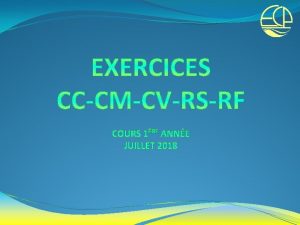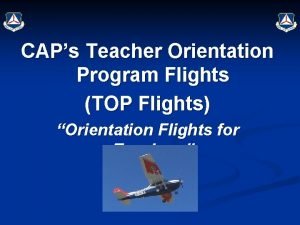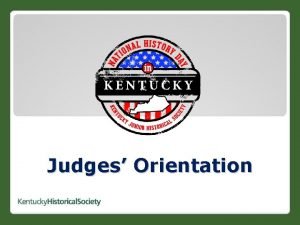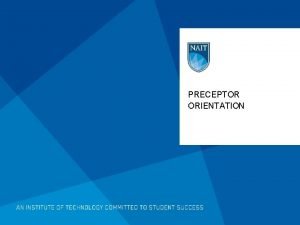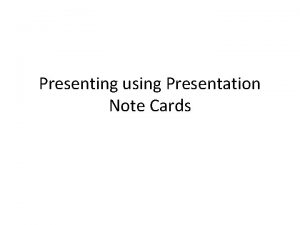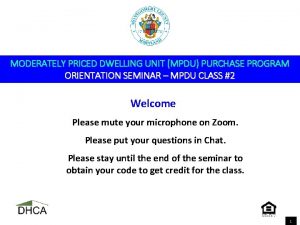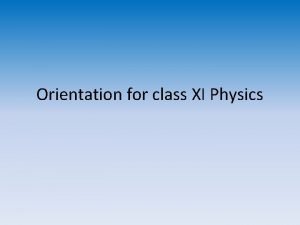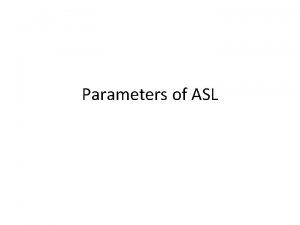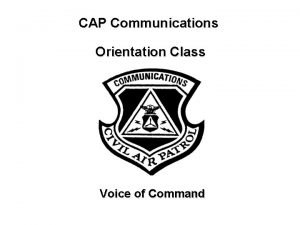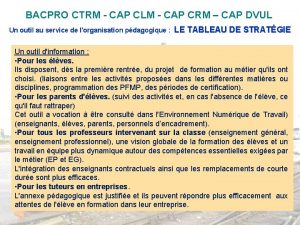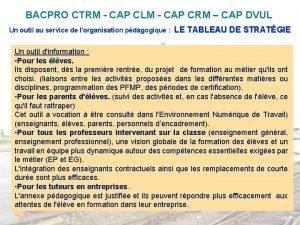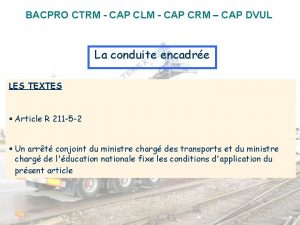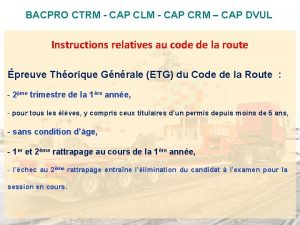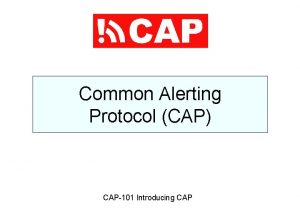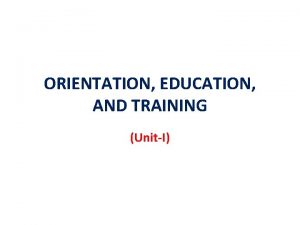CAP Communications Orientation Class Note This presentation does








































- Slides: 40

CAP Communications Orientation Class Note: This presentation does NOT contain any For Official Use Only (FOUO) information. Voice of Command CAP Basic Communications Orientation Course (Feb 2006) Developed by: LTC Bruce Bream Ohio Wing/Eagle Squadron February 2006

Basic Communications Course Overview • Licensing • Operators and Radio Stations • Call Signs • Radio Communications Systems • Equipment Familiarization • Use of Repeaters • Radiotelephone Operating Procedures • Timekeeping and Date-Time Groups • Prowords • Phonetic Alphabet • Radio Nets • Message Forms • Distress and Emergency Communications • Radio Communication Practice CAP Basic Communications Orientation Course (Feb 2006)

CAP Radio Operator Licensing TWO Levels of Operator Licensing: Communications Orientation National Headquarters Civil Air Patrol Maxwell AFB AL 36112 -6332 RADIO OPERATOR AUTHORIZATION Name and address of operator: JOHN E. DOE CHARTER SER-AL-001 ISSUED: 05 -03 -95 • 2 -3 Hour Class on: – Standard Operating Procedures – Local Operating Procedures • Entitles CAP member to operate a CAP Radio • Issued a Radio Operator Authorization (ROA) by Ohio Wing Card No. : AL-00123 Expiration: ON MEMBERSHIP Advanced Communications User Training • 4 -5 Hour Class • Pass the Advanced Communications User Test, CAPF 119 • Entitles CAP member to be assigned a call sign for their radio • Required as part of the Communications Specialty Track The regulation for all CAP Communications is CAPR 100 -1 CAP Basic Communications Orientation Course (Feb 2006)

CAP Radio Station Licensing National Telecommunications and Information Administration (NTIA) Licenses Federal agencies • Department of Defense • Department of Homeland Security • Civil Air Patrol • FEMA, NASA, EPA, USPS, Etc. Federal Communications Commission (FCC) Licenses Public radio stations • TV, FM, AM commercial broadcasters • Amateur Radio, FRS, Citizens band • CAP is a considered a federal agency for radio licensing • Federal agencies are not allowed to use services allocated exclusively to the public sector for their business • Amateur Radio and Citizens Band cannot be used for CAP business • Family Radio Service (FRS) – On ES missions: limited to communication with victims to expedite a rescue – May be used for all non-ES mission activities on a non-interference basis CAP Basic Communications Orientation Course (Feb 2006)

Types of Stations & Tactical Call Signs Ohio Wing Call Sign Examples GROUND & MOBILE AIRMOBILE CAPFLIGHT 3421 Columbus 104 Columbus 401 Ground & Mobile Reserved Call signs Last digit assigned to command staff: . . 1 Commander (C 101). . 2 Deputy (C 302). . 3 Chief of Staff (C 1003). . 4 Communications (C 4). . 5 Chaplain (C 705) CAP Basic Communications Orientation Course (Feb 2006) First two digits are Wing number Airmobile Call Signs • CAP Corporate Aircraft are always CAPFLIGHT except, • CAPFLIGHT RESCUE used only during actual missions Member-owned aircraft • Use assigned CAPFLIGHT for reimbursable missions • Otherwise, use tail number

CAP Communications Systems CAP Frequencies FAA Aeronautical Frequencies ØHF - Long-range (50 -1000+ miles) • Uses FAA frequencies • Communicate with all radio equipped aircraft Range determined by time of day, frequency, and sunspot cycle ØVHF - Short-range (5 -50 miles) Satellite Digital Imaging System (SDIS) Capabilities • Used for digital imaging • Data relayed through satellite ISR (Intra Squad Radios) • Short range (2 -3 miles) Range determined by “radio horizon” HF Static HF SSB • Similar to FRS radios Voice is the primary means of communication CAP Basic Communications Orientation Course (Feb 2006) Sounds

Voice Operating Modes SIMPLEX Single Frequency - One Station at a Time F 1 REPEATER Frequency 1 Frequency 2 Two Frequencies - One Station at a Time F 1 F 2 Input R T Output Your radio switches to Frequency 2 when you press the PTT switch CAP Basic Communications Orientation Course (Feb 2006)

Repeater Operational Advantage Output Input Repeaters increase the range of mobile stations due to the high profile location typically covering a 20 -50 mile radius CAP Basic Communications Orientation Course (Feb 2006)

Inside the Repeater retransmits if it hears one of two sub-audible tones: 1) Universal Access Tone or 2) Repeater site specific tone Input Channel Voice + Sub-audible Tone Receiver Tone Decoder Voice PTT Tone Decoder “listens” for either the universal or site specific tone on the incoming signal Transmitter + Repeater “Mike Button” Sub-audible Tone Decoder “presses” the Push To Talk (PTT) button to turn on the repeater’s transmitter Radio must be set to the correct 1) transmit channel, and 2) sub-audible tone to use the desired repeater CAP Basic Communications Orientation Course (Feb 2006) Output Channel Voice

Ohio Wing Voice Repeaters Operating on CAP VHF-FM Repeater Locations: • Cambridge • Carey • Cincinnati • Columbus • Dayton • Jackson • Lafayette • Lancaster • Lima • New Philadelphia • Thompson • Wauseon If you are not sure which repeater to select: ØUse the Universal Access Tone CAP Basic Communications Orientation Course (Feb 2006)

Airmobile use of Repeaters • Primary mode of operation should be simplex • Repeaters can be used if simplex not possible • Selectively use a repeater through use of its assigned sub-audible access tone • Use of universal tone is prohibited since this will bring up multiple repeaters • The key is to limit use to a single repeater CAP Basic Communications Orientation Course (Feb 2006)

FAA Aeronautical SAR Stations • Air-Ground Communications on FAA aircraft frequencies • Aeronautical Search And Rescue (SAR) ground stations operate on two Aircraft Frequencies: – 122. 9 MHz - TRAINING Only – 123. 1 MHz - ACTUAL Missions Only • Ground Station Call Signs assigned by geographical location » “THIS IS Lost Nation Base OVER” ELTs - Training & Actual 121. 775 MHz Training transmitters 121. 5 MHz Actual ELTs CAP Basic Communications Orientation Course (Feb 2006)

Basic Radio Station Operation Summary Power (On/Off) • Usually part of Volume control • Battery powered radios should be turned off when not being used to conserve the batteries Volume • Set to easily hear stations but not annoyingly loud • On portable radios the higher the volume, the more battery power is used and the sooner the battery runs out Squelch • Adjusts the point where audio and noise (hiss) are suppressed (quiet) • Adjust until noise is heard and then back off to just past the point where the noise stops • Some newer radios do not have a squelch knob Channel Selector • Selects both receive and transmit frequencies • Unless it is a corporate radio, there is no assurance that the frequencies are set the same on the channel selector. Know the frequencies in use and how your radio is set up or programmed • Consult the person who furnished the radio for the specific settings for the radio Microphone • Speak into the microphone using a normal speech level • Don’t yell or whisper; Shouting does not increase intelligibility or range Push to Talk (PTT) Switch • Press the PTT when talking; Release PTT to listen • Monitor the channel for a few seconds before you transmit to ensure that you don’t interfere with other traffic prior to pushing the PTT CAP Basic Communications Orientation Course (Feb 2006) 13

Basic Radio Station Components Power Sources • 120 VAC Power Supply • 12 VDC • Generator • Batteries 120 VAC Outlet Power Supply Ground • Required for Electrical Safety 1 V S C Radio Transceiver • Designed for a single or multiple frequency band modes • CAP VHF-FM • CAP HF-SSB • FAA VHF-AM CAP Basic Communications Orientation Course (Feb 2006) Antenna • Frequency sets relative size • VHF-FM • Magnetic Mount • Fixed vertical • HF-SSB • 50 foot Dipole • Fixed vertical • Bumper mount vertical Antenna Coax • Special cable that connects radio to antenna

Radios you will see in CAP VHF-FM NAT NPX-138 Tait 2020 II E. F. Johnson 5317 “Stealth” mobile Neutec SM-1645 CAP HF-SSB FAA Aircraft VHF-AM E. F. Johnson 5112 portable Intra Squad Radio (ISR) Motorola Micom-2 Tait T 196 Icom IC-4008 M ICOM A-22 CAP Basic Communications Orientation Course (Feb 2006) 15

Tait T 2000 II CAP VHF-FM Direct channel number entry possible with keypad and enter key Up / Down buttons change the channel Note: • These Tait 2020 radios are factory-modified for CAP • A standard Tait 2020 purchased on your own from other than CAPMart will not be NTIA compliant CAP Basic Communications Orientation Course (Feb 2006)

E. F. Johnson 5317 “Stealth” CAP VHF-FM Channel / Group Knob • Toggles its function each time you press it in • Turn to select channels or groups • There are 16 memory groups with 10 channels per group • Groups and channels are labeled with text names CAP Basic Communications Orientation Course (Feb 2006)

E. F. Johnson 5112 Portable CAP VHF-FM On-Off-Volume and Squelch PTT Channel Selector Microphone CAP Basic Communications Orientation Course (Feb 2006)

Neutec SM-1645 CAP VHF-FM It is important to note whether the PRI light is on or off The display only shows a number, so you must have a list or card of how it is programmed CAP Basic Communications Orientation Course (Feb 2006) Check channel card attached to top of radio Selects one of 16 numbered channels Pressing the PRI button gets to a second bank of 16 channels - It is NOT a priority button

NAT NPX-138 Radio Operation CAP VHF-FM Features: • FAA accepted for aircraft use • 100 pre-programmed channels • Same channels in all aircraft • Operates from 138 -174 MHz • “Guard” channel monitor • Use with CAP as well as Coast Guard, State Highway Patrol, and local Police Controls: MN Main Volume & On/Off - (Channel activity light to right of MN knob) GD Guard Channel Volume (Leave CCW) SCAN/NORM/GDTX Leave in NORM GD 1/GD 2 Guard Channel Select GD 1=Repeater (Ch 1) GD 2=Air/Ground (Ch 4) DISP ID=Channel Name, RX=Receive frequency, TX=Transmit Frequency CHAN +/- Step up/down through programmed channels BRIGHT +/- Change display brightness EDIT Don’t move this switch! SQ Push to open squelch to check volume and weak signals Operation: Powers up with other radios as shown above Turn on (if necessary), Set Channel, Adjust Volume, Check Squelch, Set Audio Panel CAP Basic Communications Orientation Course (Feb 2006)

Motorola MICOM-2 CAP HF SSB Radio • Channels are switched via the up/down buttons • Function button toggles between various displays including the frequency and the channel number CAP Basic Communications Orientation Course (Feb 2006)

Intra Squad Radio (ISR) • Similar to FRS radios but on shared-use federal government frequencies • Designed for ground team use and large functions like encampments and schools • Not issued to individuals - issued in deployable packages • Won’t talk with CAP VHF-FM radio system • NHQ furnished radios and cases, but no batteries • Cost of ni-cad battery and charger almost equal to cost of radio itself • Ni-cads available run 10 hours before needing recharge • Alkaline AA batteries last 30 hours max before requiring replacement • Commanders, and ES Officers should plan for readily available batteries • Incident Commanders and Mission Coordinators should anticipate battery expenses for actual and practice missions • ISR battery costs are reimbursable on CAPF 108 if mission/SAREX is reimbursed (with receipts, complete forms, etc. ) • Project Officers for encampments and training activities should anticipate and plan for battery costs • Flight-line supervisor should use VHF-FM (Ch 4) to marshal pilots in aircraft • ISR frequencies are shared with other DOD agencies CAP Basic Communications Orientation Course (Feb 2006)

Zulu Time is Standard Time • Known as Universal Coordinated Time (UTC) based on an accurate atomic clock • Similar to Greenwich Mean Time (GMT) - based on mean earth rotation Zulu time is the same, no matter what time zone you are in Standard Time Zones: EST Eastern +5 = Z CST Central +6 = Z MST Mountain +7 = Z PST Pacific +8 = Z 1 hour less for Daylight Saving Time EDT +4 = Z WWV Time Broadcast CAP Basic Communications Orientation Course (Feb 2006)

CAP Basic Communications Orientation Course (Feb 2006)

Date-Time Group 16 0218 Z APR 01 Date Time Month Year Date and Time in ZULU Don’t forget to account for change in day, month or year ZULU - Means that time is UTC (Coordinated Universal Time) Z = EST + 5 hours CAP Basic Communications Orientation Course (Feb 2006) Z = EDT + 4 hours A DTG specifies one minute in a century 25

Date-Time Group Practice making a DTG for the following times/events: • Right Now • July 7, 1997 3: 07 am • Apollo 11 Moon Landing, 7/20/1969, 4: 17 EDT • April 15, 2001 9: 18 pm • ELT Heard: Feb 28, 2005 7: 21 pm • What local date/time is 010459 Z JAN 05? CAP Basic Communications Orientation Course (Feb 2006)

PROWORDS Special words used for Clarity and Brevity in communications Most commonly used prowords: • • • THIS IS ROGER OVER OUT WAIT SAY AGAIN CORRECTION WILCO AFFIRMATIVE CAP Basic Communications Orientation Course (Feb 2006) Preface to your call sign Last transmission received OK I’m done, go ahead I’m done, bye I will be back in a few seconds Say that again Oops! I really meant to say ROGER and I will comply Yes

Phonetic Alphabet & Numbers A B C D Alpha Bravo Charlie Delta (Al fah) E F G H I J K L M Echo Foxtrot Golf Hotel India Juliet Kilo Lima Mike (Eck-oh) (Brah voh) (Char lee) (Dell tah) (Foks trot) (Golf) (Hoh tell) (In dee ah) (Ju lee ett) (Kee loh) (Lee mah) (Mike) CAP Basic Communications Orientation Course (Feb 2006) N O P Q November Oscar Papa Quebec (No vem ber) R S T U V W X Y Z Romeo Sierra Tango Uniform Victor Whiskey X-Ray Yankee Zulu (Row me oh) (Oss cah) (Pah pah) (Keh beck) (See air rah) (Tang go) (U nee form) (Vik tah) (Wiss kee) (Ecks ray) Pronunciation of Numbers 1 2 3 4 5 6 7 8 9 10 Wun Too Tree Fo-wer Fife Six Seven Ate Niner 0 Zero (Yang kee) (Zoo loo) 28

Contacting Another Station • To Establish Contact – “Columbus 40 THIS IS CAPFLIGHT 3421 OVER” • Response from the Ground Station – “CAPFLIGHT 3421 THIS IS Columbus 40 OVER” • No need to use call signs until communications are complete • Say “OVER” before releasing PTT on mike • On Closing the Contact – “… CAPFLIGHT 3421 OUT” ü Always end a transmission with OVER or OUT - NOT BOTH! ü Do not use “Roger Wilco” instead of Wilco. “Roger Wilco” means “Last transmission received OK last transmission received OK and I will comply. ” CAP Basic Communications Orientation Course (Feb 2006)

Radio Net Operation A Formal Net controls flow of traffic on a single radio channel • Net Control Station (NCS) – Maintains net discipline by controlling who is talking – Must be contacted first for permission to contact another station: “Columbus 10 THIS IS Columbus 404 with a Priority message for Columbus 710 OVER” • Sample Net Check-in (C 10 is the NCS): “Columbus 10, THIS IS Columbus 404 with no traffic, OVER” • Acknowledging readiness to receive traffic: "THIS IS Columbus 710, GO AHEAD with your traffic OVER" • Acknowledging receipt of a message: "THIS IS Columbus 710, ROGER your message OUT" CAP Basic Communications Orientation Course (Feb 2006)

Radio Nets - Contacting another Station “Columbus 10, THIS IS Columbus 401 with traffic for Columbus 404 OVER” C 10 NCS d 2 n “Columbus 401, Contact Columbus 404 with your traffic, OUT” t 1 s “Columbus 404, THIS IS Columbus 401, OVER” C 401 C 404 3 rd All transmissions must receive permission from the Net Control Station (NCS) CAP Basic Communications Orientation Course (Feb 2006)

I SPELL / FIGURES / INITIALS • Use “I SPELL” for pronounceable words – Example: LODI » “I SPELL LODI LIMA OSCAR DELTA INDIA LODI” • Use “FIGURE(S)” AND “INITIAL(S)” for non-words – Example: N 516 F » “INITIAL NOVEMBER FIGURES FIVE ONE SIX INTIAL FOXTROT” CORRECTIONS Use proword “CORRECTION” Example: “… Turn right at next corner … CORRECTION Turn left at next corner…” CAP Basic Communications Orientation Course (Feb 2006)

SENDING NUMBERS Prowords: “FIGURES”, “DECIMAL”, “TIME”, “INITIALS” Digit-by-Digit Not “Seven Fifty” 750 “FIGURES SEVEN FIVE ZERO” Niner Not Nine 849 “FIGURES EIGHT FOUR NINER” Decimal Point 14. 5 “FIGURES ONE FOUR DECIMAL FIVE” Z Time 1635 Z “TIME ONE SIX THREE FIVE ZULU” Initial And Figures E 21 “INITIAL ECHO FIGURES TWO ONE” One Figure and Initial 3 -A “FIGURE THREE DASH INITIAL ALPHA” CAP Basic Communications Orientation Course (Feb 2006)

CAP RADIO MESSAGE FORMAT (CAPF 105) Message Heading • Precedence (Urgency) • Date-Time Group (DTG) • From (Originator) • To (Addressee) • Info (Other Addressees) Message Text • When read, separate from heading and end by the proword “BREAK” Receipt Block • FROM or TO Call Sign • DTG received or sent • Initials of radio operator CAP Basic Communications Orientation Course (Feb 2006)

Message Precedence Other Precedence you may hear but not used by CAP. Both are handled before Priority or Routine Traffic. PRIORITY (P) • Used For Messages Where “Routine” Isn’t Fast Enough • Processed Ahead Of Routine Messages, not to exceed 6 hours ROUTINE (R) • Most Used; Delivered In Order Received, no later than beginning of next duty day CAP Basic Communications Orientation Course (Feb 2006) FLASH • Highest Priority • Handled as fast as possible, ahead of All other messages IMMEDIATE (O) • Messages related to situations gravely affecting the security of the Nation • Requires immediate delivery not to exceed 60 minutes

Distress and Emergency Signals MAYDAY PAN SECURITE Distress Urgency Safety } Supercedes all Priority or Routine Traffic Operator Responsibility #1 #2 LISTEN Be Prepared to Assist Do NOT Transmit unless your services are needed or contact is requested CAP Basic Communications Orientation Course (Feb 2006)

PROHIBITED Operating Practices • • Violation of Radio Silence Personal Conversation Use of given names or nicknames in place of call sign Excessive tuning and testing Profane, indecent, or obscene language Interruption of scheduled net activities in progress Transmitting in a Net without permission of NCS Leaving a directed net without the permission of the NCS, except in emergency situations or equipment failure Other discouraged practices • Use of 10 codes or Amateur Radio Q Signals • Transmitting radio frequency info over the air (FOUO) • Use of Amateur Radio or Citizens Band frequencies for CAP business CAP Basic Communications Orientation Course (Feb 2006)

Good Radio Operator Habits • Always listen before transmitting • Listen for your callsign; Other stations may have traffic for you • Speak clearly and slowly • Annunciate your words • Speak clearly and in a normal voice when transmitting • Remain calm no matter what happens -- “Don’t Panic” • THINK -- “Use Your Head” • Read the message as written – If you don’t understand it, ask the Originator – ONLY the Originator can change the message • Keep your traffic short and succinct CAP Basic Communications Orientation Course (Feb 2006)

Radio Signal Reports Signal Strength LOUD GOOD WEAK VERY WEAK FADING Your signal is very strong Your signal strength is good Your signal strength is weak Your signal strength is very weak At times your signal strength fades to such an extent that continuous reception cannot be relied on Readability CLEAR READABLE UNREADABLE DISTORTED WITH INTERFERENCE INTERMITTENT The quality of your transmission is excellent The quality of your transmission is satisfactory The quality of your transmission is so bad that I cannot understand you Having trouble understanding you because your signal is distorted Having trouble understanding you due to interference Having trouble understanding you because your signal is intermittent Example: “Loud and Clear, Over” CAP Basic Communications Orientation Course (Feb 2006) Reports such as: “Four By Four” “Five By Five” “ 20 Over S 9” will NOT be used

Radio Operation Practice Messages • Mission sortie assignment • Mission status report • Radio signal report • Ground Team position report • Takeoff / Landing time and airport report • Reporting a clue or find • Passing information or directions • Request relay to regain communications "I am often asked how radio works. Well, you see, wire telegraphy is like a very long cat. You yank his tail in New York and he meows in Los Angeles. Do you understand this? Now, radio is exactly the same, except that there is no cat. “ Attributed to Albert Einstein CAP Basic Communications Orientation Course (Feb 2006)
 Golf handicap regulering beregning
Golf handicap regulering beregning Cap compas
Cap compas Cap orientation
Cap orientation Difference between note making and note taking
Difference between note making and note taking Signal words example
Signal words example Difference between note making and note taking
Difference between note making and note taking Goods received note
Goods received note Draw a specimen of debit note
Draw a specimen of debit note What is debit note
What is debit note Relevance of note making
Relevance of note making Simple interest note vs simple discount note
Simple interest note vs simple discount note Thank you note to preceptor after orientation
Thank you note to preceptor after orientation Preceptor
Preceptor Thank you note to preceptor after orientation
Thank you note to preceptor after orientation Polycentric approach example
Polycentric approach example Unified communications presentation
Unified communications presentation Voice communication army
Voice communication army Cue cards for speech
Cue cards for speech New teacher orientation presentation
New teacher orientation presentation Mpdu seminar
Mpdu seminar What is orientation in chemistry class 11
What is orientation in chemistry class 11 Physics orientation
Physics orientation Powder keg of europe ww1
Powder keg of europe ww1 Who was the first person to arrive at juliet's tomb
Who was the first person to arrive at juliet's tomb Burlington orientation
Burlington orientation Palm orientation asl examples
Palm orientation asl examples Diameters of fetal head
Diameters of fetal head Leopold's maneuver
Leopold's maneuver Presentation topics for students in hindi
Presentation topics for students in hindi Water cycle for class 3
Water cycle for class 3 In todays lesson
In todays lesson Package mypackage class first class body
Package mypackage class first class body Difference between abstract class and concrete class
Difference between abstract class and concrete class Lower boundary of the modal class
Lower boundary of the modal class Class i vs class ii mhc
Class i vs class ii mhc Difference between abstract class and concrete class
Difference between abstract class and concrete class Tally table
Tally table Response class vs stimulus class
Response class vs stimulus class Response class vs stimulus class
Response class vs stimulus class Therapeutic class and pharmacologic class
Therapeutic class and pharmacologic class Class maths student student1 class student string name
Class maths student student1 class student string name

